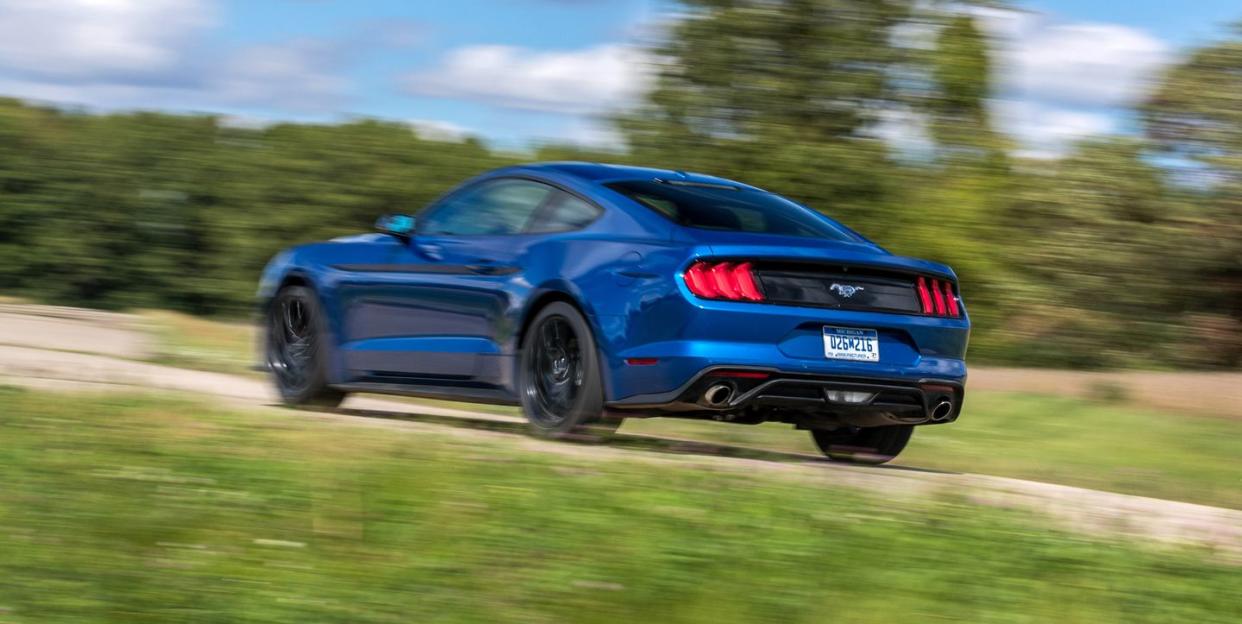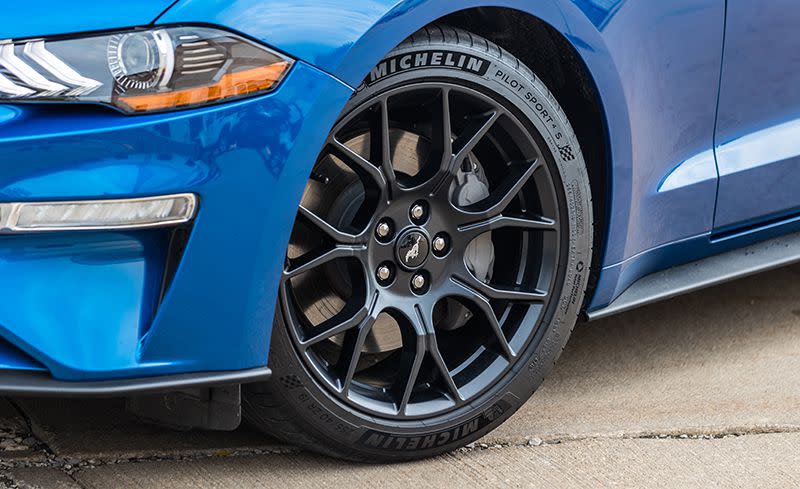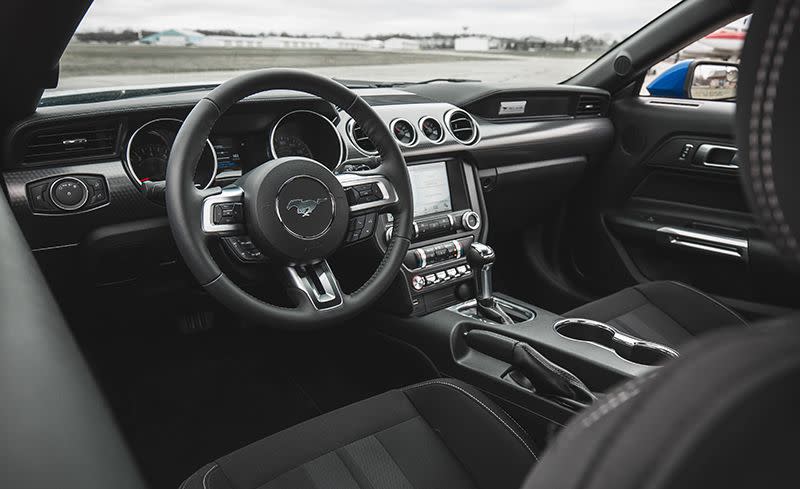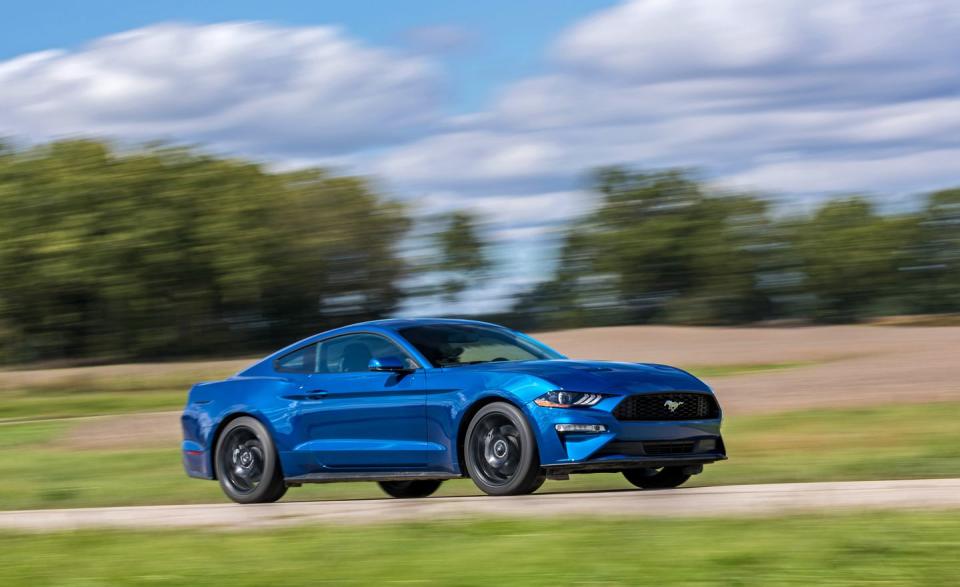The 2018 Ford Mustang's 10-Speed Automatic Makes It a Quicker Pony

The 2018 Ford Mustang, like pony cars in general, pairs best with a manual transmission. Its stoplight-racing, smoke-'em-if-you-got-'em attitude begs for three pedals of driver involvement and a slick, row-your-own shift lever between the front seats-regardless of engine choice. But with Ford and General Motors having co-developed a new 10-speed automatic, the latest's Mustang's mid-cycle update provided an opportunity for Ford's seminal pony car to receive the brand's newest transmission. While the automatic remains an option we'd skip out of personal preference, the result is indeed a quicker and more flexible Mustang.
Ford's version of the 10-speed 'box made its debut in the second-generation F-150 Raptor for 2017, later rolling out into lesser F-150s as well as the Ford Expedition and Lincoln Navigator. (GM's applications currently include V-8–powered Chevrolet Camaros and versions of its full-size trucks and SUVs with the optional 6.2-liter V-8.) In the Mustang, the 10-speed replaces the previous six-speed automatic and costs $1595 in both the four-cylinder EcoBoost and V-8 GT models. For this review, we tested fastback coupe variants with each of the available engines.
A Slight Straight-Line Boost
Both of our test cars featured their respective optional Performance packages, which add a Torsen limited-slip differential and, in EcoBoost models, alter the rear axle ratio from 3.31:1 to shorter 3.55 gears (automatic GTs keep their 3.55:1 axle). For the EcoBoost model, the package costs $2495 and also includes 19-inch wheels with 255/40ZR-19 Michelin Pilot Sport 4S summer tires, stiffer front springs, a larger-diameter rear anti-roll bar, retuned dampers, beefier brake rotors and calipers, a larger radiator, revised tuning for the ABS, stability control, electrically assisted power-steering systems, and a few other extras.
Additional equipment-notably the $2200 Equipment Group 201A (leather upholstery with contrast stitching, a 12.0-inch digital instrument cluster, upgraded interior trim, heated seats and steering wheel, navigation for the central 8.0-inch Sync 3 touchscreen, and more), $1695 MagneRide dampers, $1595 Recaro sport seats, and the $895 Shaker Pro audio system-meant that our EcoBoost Premium test car, at 3750 pounds, weighed 194 pounds more than the previous entry-level model we tested with the six-speed stick. From the Mustang Premium's $31,690 starting point (base-trim models start at $26,675), the automatic car's final tally came to $40,570.
Swapping the 310-hp 2.3-liter turbo four's manual for an automatic yielded modest improvements at the test track: its zero-to-60-mph run dropped a mere tenth, from a respectable 5.1 seconds to 5.0, with the quarter-mile pass shrinking from 13.7 to 13.5 seconds but with a 3-mph-slower trap speed of 99 mph. Lined up against the Ford's archrival, the Chevy Camaro, both EcoBoost models were within a couple of tenths of the best returns we've recorded from Camaros powered by both the 275-hp turbo four and the 335-hp V-6, regardless of transmission choice. With an excellent 0.98 g of stick on the skidpad and a 153-foot stop from 70 mph, the automatic Mustang's grip levels compared much more favorably to the manual's 0.92-g and 164-foot results on all-season tires. The automatic, however, does nothing to improve the EcoBoost four-cylinder's dull drone of an engine note.
A Stronger Showing
Our automatic-equipped GT coupe was, at 3851 pounds, 27 pounds lighter than the manual example we previously evaluated. Both models featured the GT Performance package, which, for $3995, includes similar upgrades as the EcoBoost's package, save for the GT's additional chassis bracing, staggered-width 19-inch Michelin tires (255/40ZR-19s in front, 275/40ZR-19s in back), and even larger Brembo front brakes with six-piston calipers.
Additional options that bumped our standard-level GT from its $36,185 base price to an as-tested $47,160 included the $2000 Equipment Group 301A (dual-zone climate control, ambient lighting, the 8.0-inch touchscreen with Sync 3, a nine-speaker premium stereo, selectable driving-mode toggle switches on the center stack, and Apple CarPlay and Android Auto connectivity), the $1695 MagneRide dampers, the GT's must-have $895 active-valve performance exhaust, and $795 for navigation.
At the test track, the automatic's advantage was clear as it better harnessed the 460 horses and 420 lb-ft of Ford's latest and melodious 5.0-liter V-8: The 10-speed GT rocketed to 60 mph in 3.8 seconds versus the manual's 4.3, and it shaved half a second off the quarter-mile run, posting a 12.1 at 120 mph compared to a 12.6 at 115 mph. While the 455-hp Camaro SS with the six-speed manual bettered the similar GT with 4.0- and 12.2-second figures, the automatic Ford outpaced the 2019 Chevy with a very similar 10-speed by a tenth both to 60 mph and through the quarter, and also had a 2-mph-faster trap speed. The 0.97 g that the self-shifting Mustang returned on the skidpad was similar to the manual's 0.96 g, although its 156-foot stop from 70 mph was an eight-foot improvement.
Quicker Doesn't Mean Great
Away from the test track, the 10-speed automatic's strengths are less pronounced, particularly when it comes to fuel economy. The manual four-cylinder Mustang coupe's EPA estimates are 21 mpg city and 31 highway, with the automatic good for only 1 mpg more on the interstate. Opting for the EcoBoost's Performance package, however, drops the 10-speed car's figures to 20 and 29 mpg. We averaged 21 mpg with the manual car and 20 mpg with the automatic. For the GT, the 10-speed is worth 1 mpg extra in the city to the EPA, which rates the automatic coupe at 16 mpg city and 25 highway. Yet we only managed 16 mpg overall versus 19 mpg with the stick. On our 75-mph highway fuel-economy loop, the automatic GT returned a so-so 24 mpg.
Adding to the diminished fun factor that comes from the automatic's reduced level of driver engagement, Ford's 10-speed often struggles to satisfy unless you're cruising in leisurely fashion or driving flat out. If the car is left in Normal driving mode, shifts are generally smooth and unobtrusive around town as the transmission shuffles through its ratios. Sport mode invites quicker and firmer upshifts as well as more aggressive downshifts, but the action also becomes less refined under moderate throttle inputs and clunky during multi-gear downshifts while pulling up to a traffic light. When pressed to perform, Ford's setup comes across as overly busy. Moving up to the sportier Track and Drag modes significantly increases the ferocity of the gearchanges, which are highly effective when winding out the 5.0 V-8 to its 7500-rpm redline or during hard braking for an apex on a racetrack. Yet neither setting lends the 10-speed enough sophistication to tolerate it in maximum-attack mode on the street for long.
We've logged similar complaints about the 10-speed's tuning in our long-term F-150 Raptor pickup, in which the transmission would often stumble under harder use as it rifled through its range of cogs. Ten gears are a lot to manage, and Ford has proved it can do it well, such as when backing the 440-lb-ft of torque from the F-150's new Power Stroke 3.0-liter turbo-diesel V-6 engine. But the precision and clever mapping that the nearly identical gearbox exhibits in virtually all of GM's applications shows that Ford has yet to extract the full potential from its version. It's true that opting for the Mustang's 10-speed automatic makes for a quicker and more domesticated steed, but the car rarely lets you forget that it could be better still.
('You Might Also Like',)





